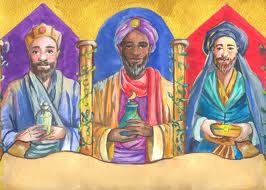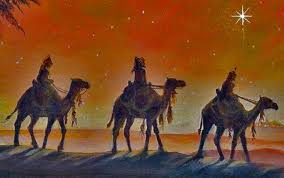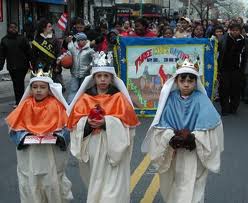 January 6 is the Three Kings Day, the day three wise men visited the baby Jesus, which is as important as Christmas in Mexico, Puerto Rico, Spain and many Latin America countries. (Also known as Epiphany).
January 6 is the Three Kings Day, the day three wise men visited the baby Jesus, which is as important as Christmas in Mexico, Puerto Rico, Spain and many Latin America countries. (Also known as Epiphany).
History of 3 Kings Day – Epiphany
Lovers of carols and Christmas parties know that this season has 12 days, packed with golden rings, calling birds and various kinds of gentry, musicians and domestic workers. December 25 is Christmas – and 25 minus 12 does equal 13. Do the math and you will see why shopping malls, newspapers, television networks, and other cultural fortresses annually deliver some kind of “Twelve Days of Christmas” blitz, beginning on December 13.
Problem is that for centuries church calendars in the East and the West have agreed that there are twelve days of Christmas and they begin on Christmas Day and end on January 6.
 The twelve days of Christmas end with the Feast of Epiphany also called “The Adoration of the Magi” or “The Manifestation of God.” Celebrated on January 6, it is known as the day of the Three Kings (or wise men/magi): Caspar, Melchior and Balthasar. According to an old legend based on a Bible story, these three kings saw, on the night when Christ was born, a bright star, followed it to Bethlehem and found there the Christchild and presented it with gold, frankincense and myrrh.
The twelve days of Christmas end with the Feast of Epiphany also called “The Adoration of the Magi” or “The Manifestation of God.” Celebrated on January 6, it is known as the day of the Three Kings (or wise men/magi): Caspar, Melchior and Balthasar. According to an old legend based on a Bible story, these three kings saw, on the night when Christ was born, a bright star, followed it to Bethlehem and found there the Christchild and presented it with gold, frankincense and myrrh.
January 6, the last day of Christmas, comes with its own traditions, rituals and symbols. Carolers are going from house to house; in many homes the Christmas tree is taken down and in some areas is burnt in a big bonfire. For the children this is an especially joyous occasion because, associated with taking down the tree goes the “plündern” (raiding) of the tree. The sweets, chocolate ornaments wrapped in foil or cookies, which have replaced the sugar plums, are the raiders’ rewards.
The history of Christmas, (the festival of the nativity of Jesus Christ,) is intertwined with that of the Epiphany. The commemoration of the Baptism (also called the Day of Lights, i.e. the Illumination of Jesus) was also known as the birthday of Jesus, because he was believed to have been born then of the Virgin or reborn in baptism. In some records Christmas and Epiphany were referred to as the first and second nativity; the second being Christ’s manifestation to the world.
In the fourth century, December 25 was finally adopted by the Western Christian Church as the date of the Feast of Christ’s birth. It is believed that this change in date gave rise to the tradition of the “12 Days of Christmas.” While the Western Christian Church celebrates December 25th, the Eastern Christian Church to this day recognizes January 6 as the celebration of the nativity. January 6 was also kept as the physical birthday in Bethlehem. In the Teutonic west, Epiphany became the Festival of the Three Kings (i.e. the Magi), or simply Twelfth day.
 On the evening before Three Kings, traditionally there were prayers, blessed dried herbs would be burnt and their aromatic smell would fill the house. Doorways would be sprinkled with holy water and the master of the house would write with chalk C + M + B and the year above the house and barn door and say: “Caspar, Melchior, Balthasar, behütet uns auch für dieses Jahr, vor Feuer und vor Wassergefahr.” (“CMB, protect us again this year from the dangers of fire and water.”) C + M + B has traditionally been translated with Caspar, Melchior and Balthasar, however, according to the Church it stands for “Christus Mansionem Benedictat” (Christ bless this home).
On the evening before Three Kings, traditionally there were prayers, blessed dried herbs would be burnt and their aromatic smell would fill the house. Doorways would be sprinkled with holy water and the master of the house would write with chalk C + M + B and the year above the house and barn door and say: “Caspar, Melchior, Balthasar, behütet uns auch für dieses Jahr, vor Feuer und vor Wassergefahr.” (“CMB, protect us again this year from the dangers of fire and water.”) C + M + B has traditionally been translated with Caspar, Melchior and Balthasar, however, according to the Church it stands for “Christus Mansionem Benedictat” (Christ bless this home).
The custom of the Star Singers, reminiscent of the travel of the Three Kings is still very much alive in Bavaria and Austria. Beginning with New Years and through January 6, children dressed as the kings, and holding up a large star, go from door to door, caroling and singing a Three Kings’ song. For this they receive money or sweets. Formerly the collected donations went to unemployed craftsmen and veterans, today they go to charities of the church or the Third World.
Oldtimers of Jasper in Indiana still remember the times when January 6 was celebrated. Lillian Doane and her family lived app. 4 miles out of town. Since it was a holy day they would go to church over the corduroy road. Claude and Martina Eckert also remember it as a special day. “People would put their trees out for the city to pick up and then all would be told that six o’clock this evening they would burn the Christmas trees. That was sometime ago; now the city will pick them up and chop them up as mulch. If you chipped in a tree you can get a bag of mulch.” For the Reichmanns in Brown County, “Dreikönigsabend” is always a special event. If there are any treats left on the tree (Ruth buys them at the Heidelberg Haus in Indianapolis), the grandchildren come to get them. In the evening there is a big gathering with Christmas foods, Glühwein and Stollen and Christmas carols with Eberhard at the piano.
© Copyright Ruth M. Reichmann
Max Kade German-American Center, IUPUI






























